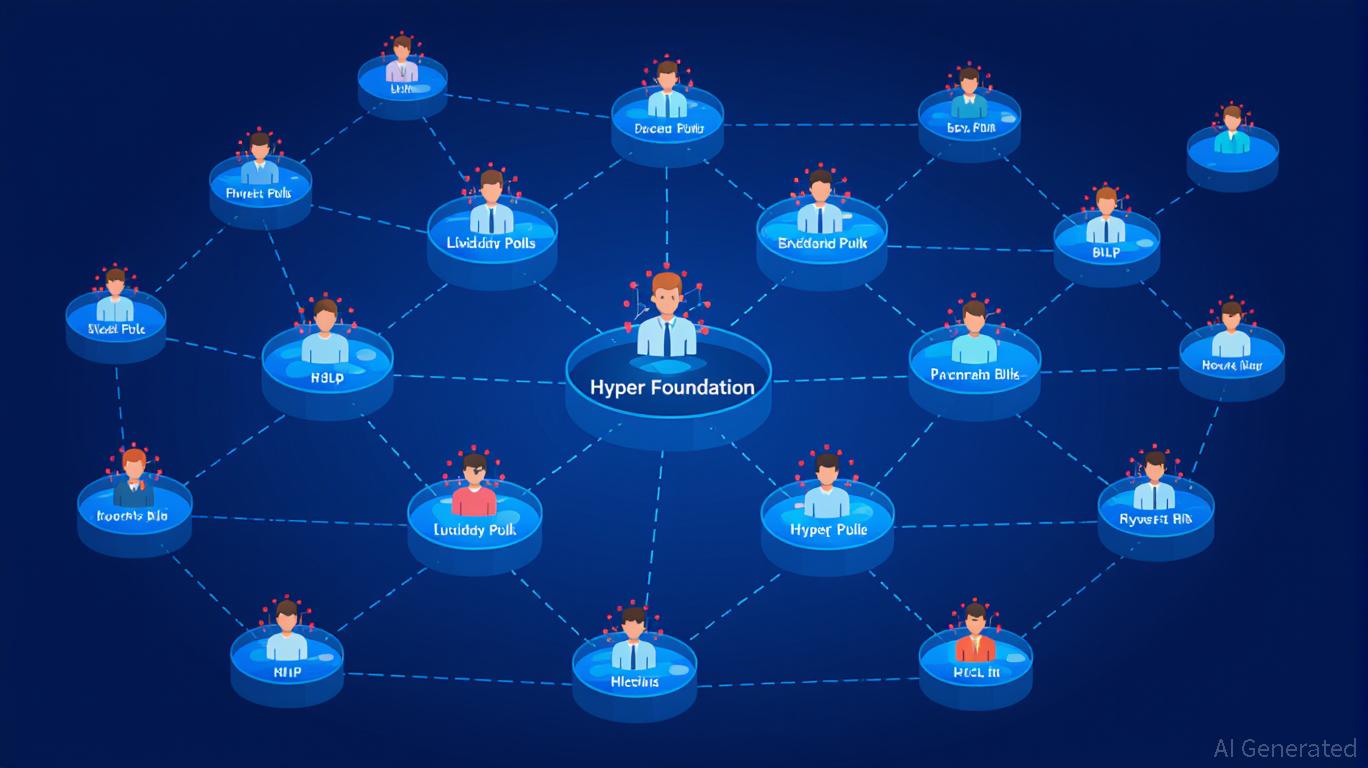Hyperliquid's Growing Influence in Crypto Trading: Can It Maintain Long-Term Investment Appeal?
- Hyperliquid dominates 80% of 2025 perpetual contract market via on-chain governance and user-driven liquidity innovations. - Centralized governance (HIP-3 protocol, USDH stablecoin launch) balances permissionless market creation with validator dominance risks. - HLP liquidity model generates $40M during crashes but faces regulatory scrutiny and token economics challenges from 2025 HYPE unlock. - TVL growth to $5B and 518K active addresses highlight adoption, yet governance centralization and institutiona
Centralized Governance and Open Innovation
Hyperliquid’s on-chain governance structure presents both opportunities and challenges. The platform operates with 24 validators, and the
A major milestone in 2025 was the USDH stablecoin introduction, which was approved through a governance vote that favored Native Markets over alternatives like Paxos and Frax, as reported by LiveBitcoinNews. Although this step lessens dependence on

User-Powered Liquidity: Strengths and Weaknesses
Hyperliquid’s liquidity framework is anchored by the Hyperliquidity Provider (HLP) vault, which aggregates user deposits to ensure constant counterparties. During a $10 billion market downturn, the HLP generated $40 million in returns, as cited by Coinotag. Additionally, the Borrow Lending Protocol (BLP) testnet allows for on-chain borrowing of assets like USDC and PURR to help manage leveraged trading risk, as reported by Bitget. These features position Hyperliquid as a bridge between centralized and decentralized finance, offering both speed and liquidity while maintaining user control.
However, the system’s dependence on HYPE token staking for launching new markets introduces certain vulnerabilities. For instance, the AERO/USDC perpetual contract, which debuted with 3x leverage, highlights Hyperliquid’s appeal to active traders but also its exposure to asset volatility, as observed by Lookonchain. Regulatory pressures add another layer of complexity, especially as rivals like BlockchainFX obtain institutional licenses, according to Cryptopolitan. Despite regulatory uncertainty, user engagement remains strong: total value locked (TVL) soared from $564 million at the end of 2024 to $5 billion by the close of 2025, according to Oak Research. Active wallet addresses also increased by 78%, reaching 518,000, per Oak Research’s data.
Sustainability: Navigating Growth and Control
The future success of Hyperliquid depends on its ability to balance centralized oversight with decentralized participation. The introduction of the HIP-3 protocol and HyperEVM (an Ethereum-compatible execution environment), as detailed in CoinMarketCap’s recent update, improves both composability and scalability, though validator concentration remains a concern. Growing institutional interest—such as 21Shares’ application for a HYPE ETF, as reported by Bitget—reflects confidence in the platform’s potential. However, price instability and leadership transitions (for example, CEO Michael Rowe stepping down) could impact investor confidence, as noted in Bitget’s coverage.
Clearer regulatory guidelines are also essential. The Jelly incident, which involved a $12 million loss from the HLP that was offset by an oracle intervention, as reported by Oak Research, highlighted the importance of strong security protocols. Hyperliquid’s buyback initiative, which uses 97% of protocol fees as per CoinMarketCap, creates deflationary pressure, but broader economic challenges and competition from centralized exchanges could threaten its market position.
Conclusion: High Risk, High Potential
Hyperliquid’s advancements in governance and liquidity have made it a frontrunner in decentralized trading. The platform’s rapid TVL growth, expanding user base, and strategic alliances (such as with Felix), as reported by Bitget, point to solid fundamentals. Still, its centralized decision-making, upcoming token unlock, and regulatory ambiguity present notable risks. For investors, Hyperliquid offers a high-risk, potentially high-reward scenario: its open market creation and HLP system could fuel ongoing expansion, but underlying structural issues warrant a cautious approach.
Disclaimer: The content of this article solely reflects the author's opinion and does not represent the platform in any capacity. This article is not intended to serve as a reference for making investment decisions.
You may also like
SpacePay’s test network demonstrates that cryptocurrency has the potential to achieve widespread adoption
- SpacePay ($SPY) raised $1.4M in presale, launching a testnet on Base/Ethereum Sepolia to validate its crypto-merchant payment protocol. - The platform enables Android POS crypto integration with 325+ wallet support, fixed 0.5% fees, and fiat settlement to mitigate volatility risks. - $SPY token offers governance rights, revenue-sharing from 0.5% fees, and community rewards like airdrops to incentivize participation. - With 34B token supply and 20% public allocation, the project combines functional infras

Zcash News Today: a16z Calls on U.S. to Adopt Privacy-Centric Technology to Stay Ahead in Digital Finance
- a16z urges U.S. Treasury to prioritize privacy-preserving identity tech in GENIUS Act implementation, advocating zero-knowledge proofs (ZKPs) and MPC for AML compliance. - Privacy-focused cryptos like Zcash (ZEC) and Midnight gain traction, with Zcash surging 1,172% YTD and GDPR-compliant Midnight attracting institutional interest. - Microsoft's "Whisper Leak" AI vulnerability highlights risks to privacy, prompting calls for obfuscation techniques to protect data in blockchain and AI ecosystems. - Regula
Tether Invests $100 Million in VCI's OOB Tokens, Connecting Conventional Finance with Blockchain Technology
- VCI Global acquires $100M OOB tokens via restricted shares and secondary market purchases, making Tether its largest shareholder. - Tether's $180B market cap and OOBIT's cross-border payments platform strengthen ties between traditional finance and blockchain ecosystems. - OOB token migration to Solana and digital treasury initiatives aim to enhance scalability, with 70% of crypto payments targeting retail/food sectors. - Mixed market reactions follow 26.55% VCIG share drop, though analysts highlight sta

DODO Rises 2.11% on November 12, 2025 Despite Ongoing Yearly Decline
- DODO rose 2.11% on Nov 12, 2025, but remains in a 12-month bearish trend with an 80.93% annual decline. - Analysts debate if the short-term rebound signals a critical support level reversal amid oversold RSI conditions (30) and downtrend indicators. - A backtest strategy evaluates historical cases of similar sharp one-day gains (-80.93% annual drop + 2.11% daily rise) to assess reversal probabilities.